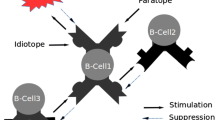Abstract
An artificial immune system was modelled with self/non-self selection to overcome abnormity in a mobile robot demo. The immune modelling includes the innate immune modelling and the adaptive immune modelling. The self/non-self selection includes detection and recognition, and the self/non-self detection is based on the normal model of the demo. After the detection, the non-self recognition is based on learning unknown non-self for the adaptive immunization. The learning was designed on the neural network or on the learning mechanism from examples. The last step is elimination of all the non-self and failover of the demo. The immunization of the mobile robot demo is programmed with Java to test effectiveness of the approach. Some worms infected the mobile robot demo, and caused the abnormity. The results of the immunization simulations show that the immune program can detect 100% worms, recognize all known Worms and most unknown worms, and eliminate the worms. Moreover, the damaged files of the mobile robot demo can all be repaired through the normal model and immunization. Therefore, the immune modelling of the mobile robot demo is effective and programmable in some anti-worms and abnormity detection applications.
Similar content being viewed by others
References
Gong T, Cai Z X. Mobile immune-robot model[C]// Proceedings of IEEE International Conference on Robotics, Intelligent Systems and Signal Processing. Changsha, 2003, 8–13.
Franz M O, Mallot H A. Biomimetic robot navigation[J]. Robotics and Autonomous Systems, 2000, 30(1): 133–153.
YU Jun-zhi, WANG Shuo, TAN Min. Basic motion control of a free-swimming biomimetic robot fish[C] // Abdallah C T. Proceedings of the 42nd IEEE Conference on Decision and Control. Maui, 2003, 9–12.
Jerne K N. Towards a network theory of the immune system[J]. Ann Immunol (Paris), 1974, 125C: 373–389.
Deem M W, Lee H Y. Sequence space localization in the immune system response to vaccination and disease[J]. Physical Review Letters, 2003, 91(6): 068101-1–068101-4.
Balthrop J, Forrest S, Newman E J M, et al. Technological networks and the spread of computer viruses[J]. Science, 2004, 304(5670): 527–529.
Dasgupta D, González F. An immunity-based technique to characterize intrusions in computer networks[J]. IEEE Transactions on Evolutionary Computation, 2002, 6(3): 281–291.
Harmer K P, Williams D P, Gunsch H G, et al. An artificial immune system architecture for computer security applications[J]. IEEE Transactions on Evolutionary Computation, 2002, 6(3): 252–280.
Branco P J C, Mendes R V, Dente A J. Using immunology principles for fault detection[J]. IEEE Transactions on Industrial Electronics, 2003, 50(2): 362–373.
Luh G C, Cheng W C. Identification of immune models for fault detection[J]. Journal of Systems and Control Engineering, 2004, 218(5): 353–367.
GONG Tao, CAI Zi-xing. Anti-worm immunization of web system based on normal model and BP neural network[J]. Lecture Notes in Computer Science, 2006,3973: 267–272.
GONG Tao, CAI Zi-xing. Parallel evolutionary computing and 3-tier load balance of remote mining robot[J]. Trans Nonferrous Met Soc China, 2003, 13(4): 948–952.
de Castro L N, Timmis J. Artificial immune systems as a novel soft computing paradigm[J]. Soft Computing, 2003, 7(8): 526–544.
de Castro L N, Timmis J. Artificial immune systems: a new computational intelligence approach[M]. London: Springer-Verlag, 2002.
Watkins A, Timmis J, Boggess L. Artificial immune recognition system (AIRS): an immune-inspired supervised learning algorithm[J]. Genetic Programming and Evolvable Machines, 2004, 5(3): 291–317.
LI Mei-yi, CAI Zi-xing, SUN Guo-rong. An adaptive genetic algorithm with diversity-guided mutation and its global convergence property[J]. Journal of Central South University Technology, 2004, 11(3): 323–327.
GONG Tao, CAI Zi-xing. An immune agent for web-based AI course[J]. International Journal of E-Learning, 2006, 5(4): 493–506
Taylor D W, Corne D W. An investigation of the negative selection algorithm for fault detection in refrigeration systems [C]// Timmis J, et al. Proceedings of ICARIS 2003, Lecture Notes in Computer Science. Heidelberg: Springer-Verlag, 2003: 34–45.
Author information
Authors and Affiliations
Corresponding author
Additional information
Foundation items: Projects(60234030, 60404021) supported by the National Natural Science Foundation of China; project(040125) supported by the Doctoral Research Grant of Central South University
Rights and permissions
About this article
Cite this article
Gong, T., Cai, Zx. & He, Hg. Immune modelling and programming of a mobile robot demo. J Cent. South Univ. Technol. 13, 694–698 (2006). https://doi.org/10.1007/s11771-006-0015-7
Received:
Accepted:
Published:
Issue Date:
DOI: https://doi.org/10.1007/s11771-006-0015-7




